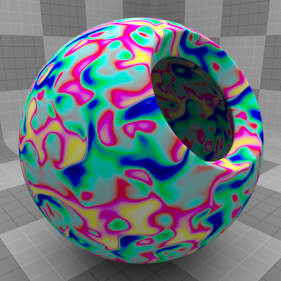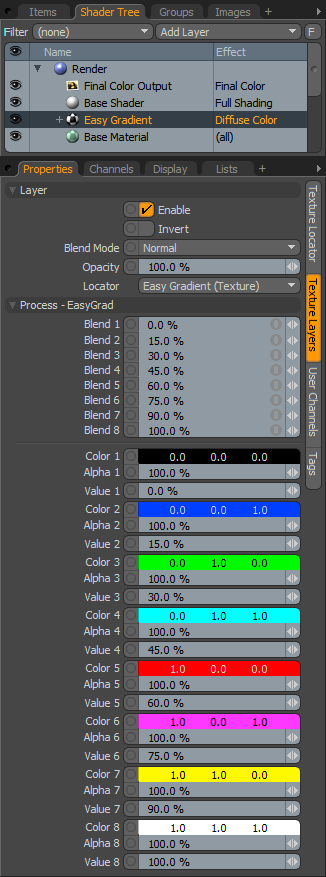Easy Gradient
Home >> Shade, Light & Render >> Shader Tree Items >> E:modo Textures >> Easy Gradient

The Easy Gradient process layer applies a user define color gradation across the grey values of any lower Shader Tree layer set to the same 'Effect' type, this makes it easy for users to colorize procedural textures that a generally defined by two colors (foreground/background). In the example above, an 'Agate' texture layer is applied, set as 'Diffuse Color' effect, with an 'Easy Gradient' layer at the default values placed directly above it in the tree also set to 'Diffuse Color'. The color gradations are applied as zones represented by the 'Blend Values'. Users can define up to 8 colors with corresponding blend zones; representing the entire grey spectrum from 0% black to 100% white.
For information regarding adding and working with Shader Tree Items Layers please reference the the Shader Tree page of the documentation.
 Layer--
Layer--
Enable: Toggles the effect of the layer on and off, duplicating the functionality of toggling visibility in the Shader Tree. When un-checked (disabled), the layer has no effect on the shading of the scene. However, disabled layers are saved with the scene and are persistent across modo sessions.
Invert: Inverts the RGB values for the layer producing a negative effect.
Blend Mode: Affects blending between different layers of the same effect type, allowing user the ability to stack several layers for different effects. For more on blending, please reference the 'Blend Modes' page of the documentation.
Opacity: Changes the transparency of the current layer. Reducing this value will increasingly reveal lower layers in the shader tree if present, or dim the effect of the layer itself on the surface.
Locator: Most texture layers also have an associated 'Texture Locator' that is automatically created in the 'Item List'. This defines the mapping of the texture (the way it is applied) to the surface. The 'Locator' option sets that association. While users can choose alternate locators, the need to do so will be very rare; still, there are some possible instances where users may want multiple texture items to share a single locator.
Process - EasyGrad --
Blend 1-8: These parameters define the blend points of the gradient.
Color 1-8: These parameters define the colors of the gradient.
Alpha 1-8: These parameters define the alpha channel of the gradient.
Value 1-8: These parameters define the opacity of the gradient.


